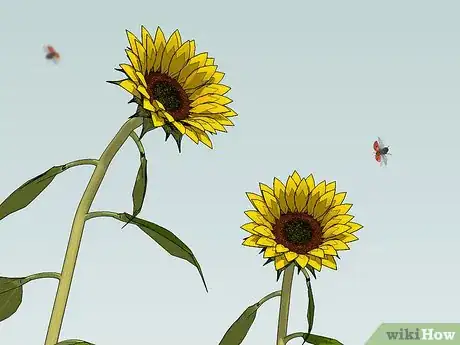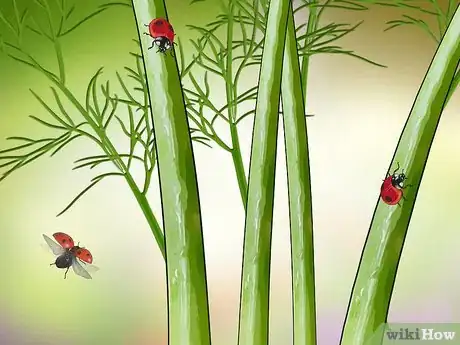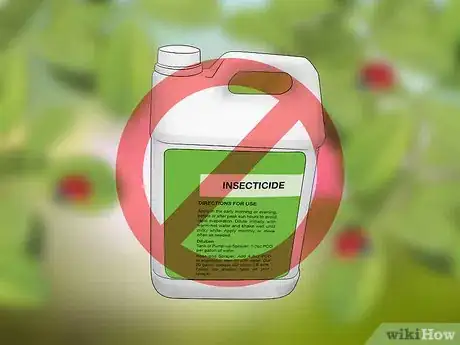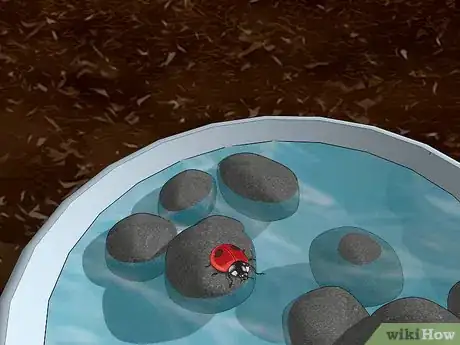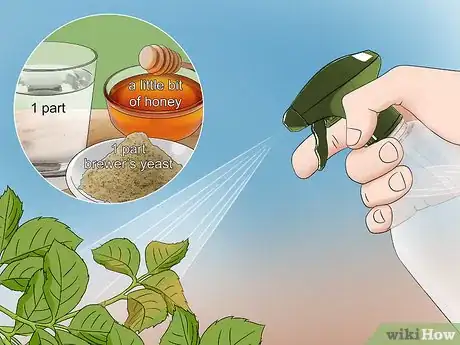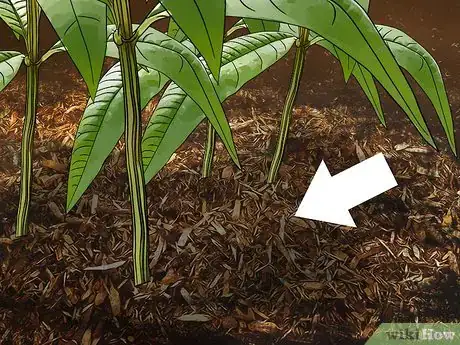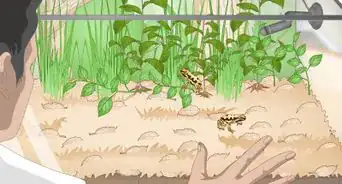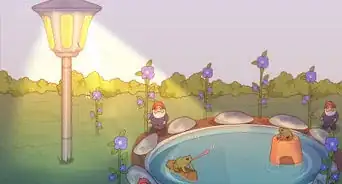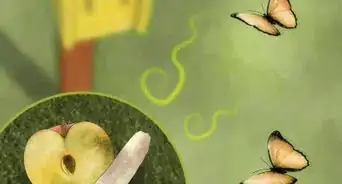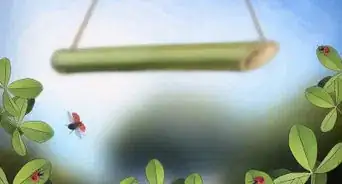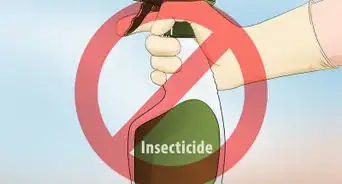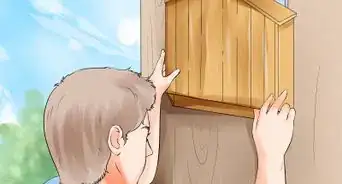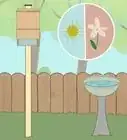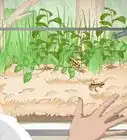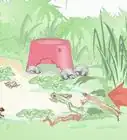This article was co-authored by Shweta Sharma. Shweta Sharma is a Biologist with the U.S. Environmental Protection Agency (EPA). With nearly ten years of experience, she specializes in insect management, integrated pest management, insect behavior, resistance management, ecology, and biological control. She earned her PhD in Urban Entomology and her MS in Environmental Horticulture from the University of Florida. She also holds a BS in Agriculture from the Institute of Agriculture and Animal Sciences, Nepal.
There are 8 references cited in this article, which can be found at the bottom of the page.
This article has been viewed 26,594 times.
There are many beneficial reasons to keep your garden teeming with ladybugs. Considered a sign of good luck in many cultures, ladybugs are also sought after for their ability to control unwanted garden pests. Whether you are looking for a safe, organic method to protect your veggies or a bit of extra luck, with a few quick tips you’ll be on your way to attracting a backyard full of these little, spotted beauties.
Steps
Growing Plants That Ladybugs Like
-
1Cultivate plants that attract ladybug food. You can easily lure ladybugs by attracting the pests that they like to eat such as aphids, mites, and scale. This might seem counterintuitive if you are trying to attract ladybugs in order to get rid of garden pests. However, a ladybug will not stick around your garden without a steady supply of food.
- Consider growing cabbage, nasturtium, and radishes, all which attract aphids—a favorite ladybug treat!
- Use these plants as decoys to draw aphids away from the plants that you’d like to protect.[1]
-
2Plant colorful fragrant flowers. White and yellow flowers seem to especially attract ladybugs. Ladybugs flock to sunflowers for their bright, yellow flower petals as well as zinnias, which have vividly colored round blooms. Both plants also make great cut flowers that are excellent for indoor decoration!
- Keep in mind that the shape and size of the flowers matter too! Ladybugs prefer flat, shallow flowers that are easy to land on and to eat from, such as dill, coriander or alyssum. Dill and coriander make great additions to your garden as they are delicious food seasonings as well.[2]
Advertisement -
3Grow plants that ladybugs like to eat. In addition to pests, ladybugs also feast on pollen and nectar from certain flowers. Ladybugs find the pollen from plants such as chives, fennel, cosmos, feverfew, marigolds, and yarrow to be extremely delicious![3]
- Because ladybugs primarily eat flower nectar and pollen not plant leaves, they won’t do visible damage to your flowers or plants.[4]
- Some species of ladybugs feast on the white, powdery mildew that can sometimes form on the leaves of squash, cucumber, and zucchini plants. Mildew can harm plants, so this is another added bonus of ladybug eating habits![5]
Providing Bugs and Water
-
1Do not use insecticides. Insecticides are harmful to ladybugs and will also destroy the ladybug’s food supply. In their larval stage, ladybugs can eat up to 400 aphids in just one week. This means they need a lot of bugs to survive, so make sure to avoid chemical sprays that will reduce their access to food.[6]
- If you absolutely must treat your plants for serious pest or fungus problems, use a natural method. Certain plant soaps and horticultural oils are safe to use around ladybugs.[7]
-
2Place dishes of water lined with rocks in your garden. Ladybugs need water to survive. Ladybugs will drink water directly from the surface of plants, but you can also guarantee a steady supply of water by placing shallow dishes of water throughout your garden. Line the bottom of the dishes with rocks to give the bugs a place to land.
- Keep in mind that stagnant water can become a breeding ground for mosquitos. Make sure to empty and refill the dishes regularly to discourage mosquitos from laying their eggs.[8]
-
3Spray plants with an artificial food solution. Once you’ve attracted ladybugs, you can encourage them to stay around by occasionally feeding them a homemade liquid food solution. This will supplement their diet of pollen and insects. You can easily make the solution by mixing equal amounts of water and brewer’s yeast together with a little bit of honey and spreading it around your garden.[9]
- Mix the solution in a spray bottle and apply it to the surface of your plants. It will not harm the plants.
Creating Ladybug Shelters
-
1Grow low, stocky plants to create ground cover. Ladybugs need a safe place to hide from predators. Give them cover from birds and frogs that may be looking to make them into a quick lunch! Low, stocky plants such as oregano and thyme will give ladybugs a safe hideout.[10]
- You can also cut and dry sprigs of oregano and thyme to use as a seasoning while you are cooking.
-
2Cover the ground with mulch or straw for additional protection. You can also provide safe hiding spots for ladybugs by covering the ground in and around your garden with mulch or straw. The mulch or straw will provide plenty of little nooks and crannies around your garden for ladybugs to get away from predators.[11]
- The ground cover will also help your soil retain nutrients and water.[12]
-
3Build a ladybug home. Ladybugs need a safe, dry place to get out of the cold and to lay their eggs. In addition to providing natural shelters, you can also construct your own ladybug shelter using a few common items.[13]
- Ladybug homes can take many different shapes and sizes, but the simplest method involves threading a piece of twine through a hollow tube (you can use a bamboo stalk, a piece of PVC pipe, or a cardboard paper towel roll), tying the string in a knot, then hanging the tube on a fence or post near your garden.[14]
- You can even place a couple of raisins inside your structure to welcome ladybugs to their new home!
Community Q&A
-
QuestionMy ladybugs aren’t eating. What should I do?
 Community AnswerTry getting a cardboard tissue roll without the paper and tie it to a tree so that it is hanging down. Put some raisins inside and then put your ladybug in there.
Community AnswerTry getting a cardboard tissue roll without the paper and tie it to a tree so that it is hanging down. Put some raisins inside and then put your ladybug in there.
References
- ↑ https://www.gardeningknowhow.com/garden-how-to/beneficial/attract-ladybugs.htm
- ↑ http://extension.colostate.edu/topic-areas/insects/lady-beetles-5-594/
- ↑ https://www.gardeningknowhow.com/garden-how-to/beneficial/attract-ladybugs.htm
- ↑ https://homeguides.sfgate.com/herbs-flowers-attracting-ladybugs-38055.html
- ↑ https://www.ladybug-life-cycle.com/what-ladybugs-eat.html
- ↑ https://homeguides.sfgate.com/herbs-flowers-attracting-ladybugs-38055.html
- ↑ http://extension.colostate.edu/topic-areas/insects/lady-beetles-5-594/
- ↑ https://www.mnn.com/your-home/organic-farming-gardening/stories/how-to-attract-ladybugs-to-your-garden
- ↑ https://www.backyardbuddies.org.au/backyard-buddies/ladybirds
- ↑ https://www.mnn.com/your-home/organic-farming-gardening/stories/how-to-attract-ladybugs-to-your-garden
- ↑ https://www.backyardbuddies.org.au/backyard-buddies/ladybirds
- ↑ https://www.daff.gov.za/Daffweb3/Portals/0/Brochures%20and%20Production%20guidelines/Poster%20Mulchin.pdf
- ↑ https://www.backyardbuddies.org.au/backyard-buddies/ladybirds
- ↑ https://www.apartmenttherapy.com/how-to-make-a-ladybug-feeder-attract-them-to-your-garden-169681

